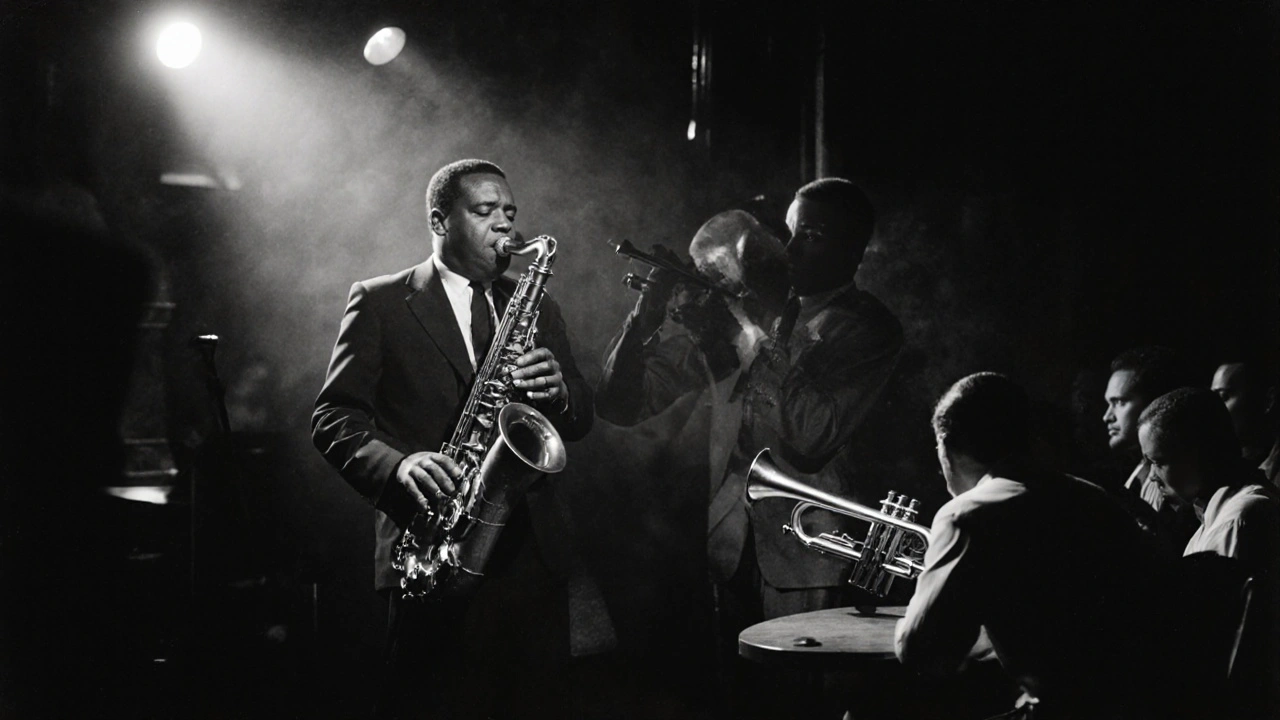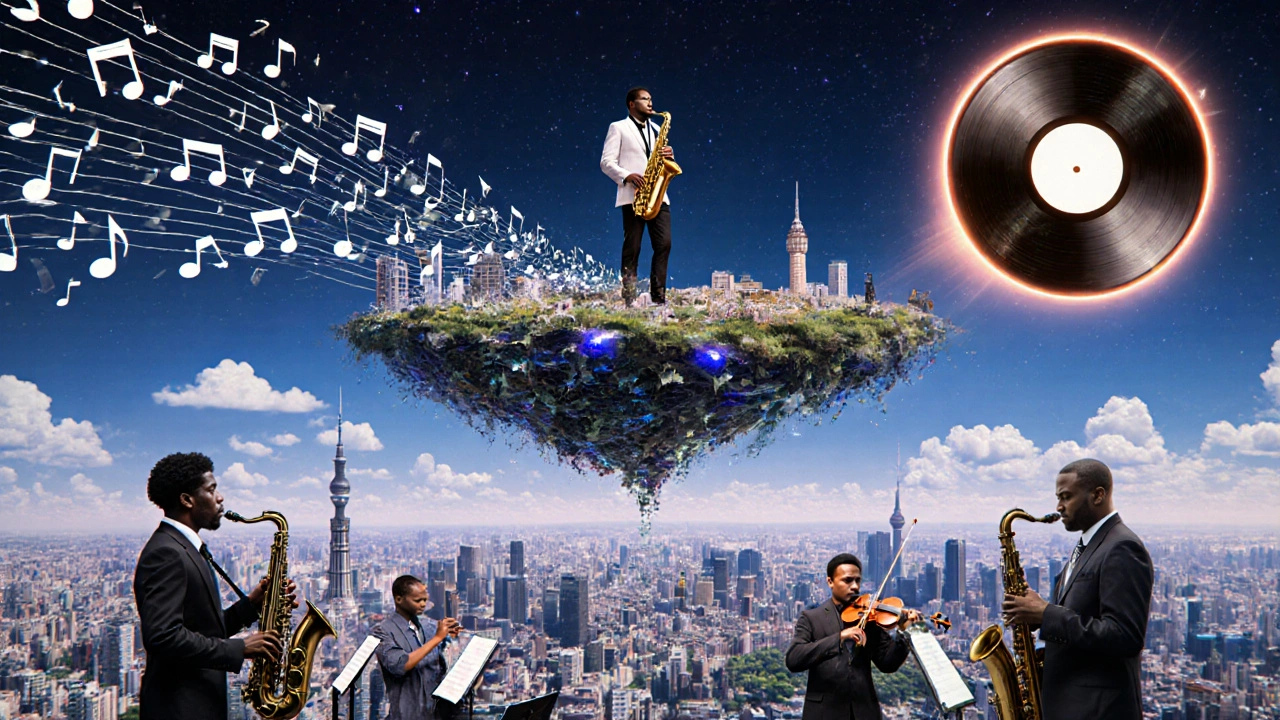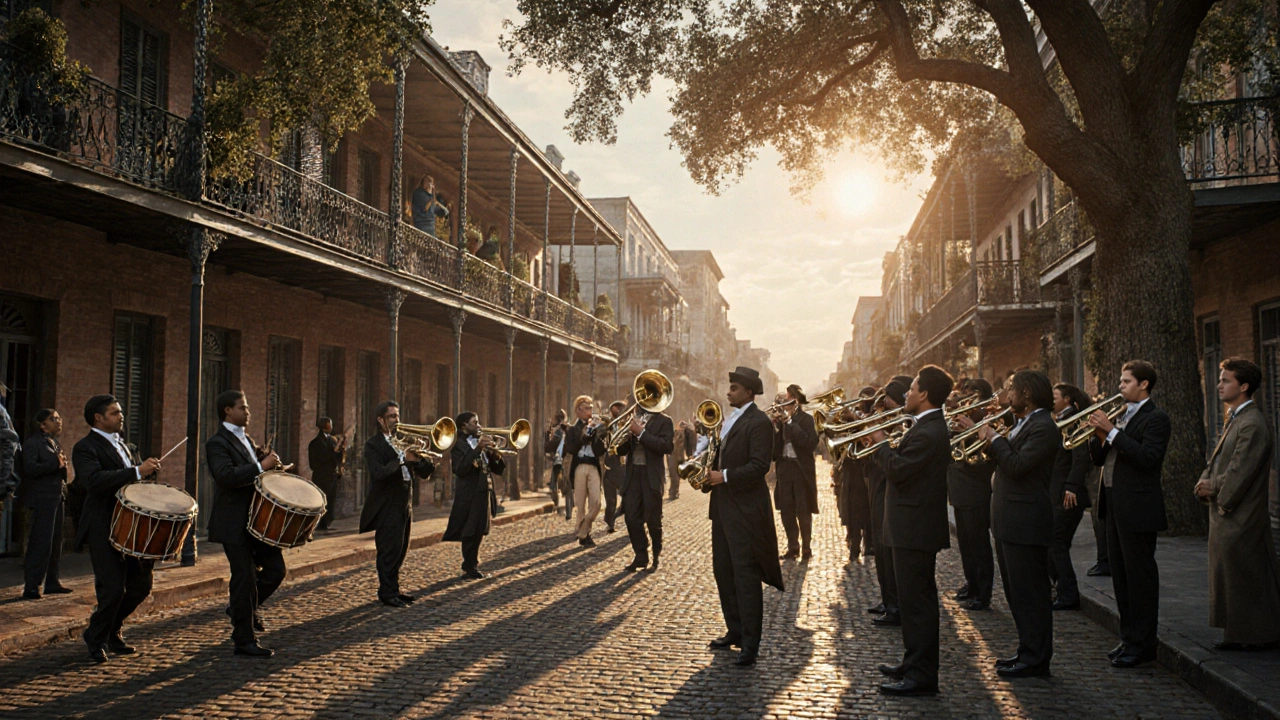When you hear a trumpet wail over a swinging rhythm, or a piano riff slide through a late-night club, you’re not just listening to music-you’re hearing history. Jazz didn’t start as a genre on a record label. It was born in the streets, churches, and dance halls of New Orleans, shaped by people who had no formal training but carried centuries of sound in their bones. Understanding jazz means understanding slavery, migration, resistance, and joy-all wrapped in syncopated beats and blue notes.
The Birthplace: New Orleans in the Late 1800s
Jazz didn’t appear out of nowhere. It grew from the mix of cultures in New Orleans, a port city where African rhythms met European harmonies, Caribbean melodies, and Native American percussion. Enslaved Africans brought polyrhythms and call-and-response patterns from West Africa. These weren’t just musical ideas-they were survival tools, ways to communicate when spoken language was forbidden.
After emancipation, freed Black communities gathered in Congo Square, where drumming and dancing kept traditions alive. Meanwhile, European immigrants brought brass instruments and sheet music. The result? A new kind of music that didn’t follow written rules. It swung, bent, and improvised. That freedom became jazz’s heartbeat.
Early jazz musicians didn’t call it jazz. They called it ragtime, dixieland, or just “hot music.” The word “jazz” itself didn’t stick until the 1910s, and even then, it was slang-sometimes crude, always alive. By 1917, the Original Dixieland Jass Band recorded the first jazz record. It sold over a million copies. Suddenly, the music of Black neighborhoods was being played in white ballrooms across the country.
The Great Migration and the Spread of Sound
Between 1916 and 1970, over six million Black Americans moved out of the South. This was the Great Migration. And with them came jazz. They took it north-to Chicago, then to New York, Kansas City, and beyond. In Chicago, Louis Armstrong turned solo improvisation into an art form. His 1926 recording of “West End Blues” showed how a trumpet could cry, laugh, and speak all in one phrase.
New York became the center of jazz innovation. Harlem’s Cotton Club and the Apollo Theater turned jazz into nightlife spectacle. But behind the glitter, Black artists still faced segregation. Duke Ellington played for white audiences at the Cotton Club, but couldn’t sit at the same tables as his fans. Still, he composed complex suites that blended jazz with symphonic structure, proving the genre could be both popular and profound.
By the 1930s, big bands ruled. Benny Goodman, a white clarinetist, brought swing to mainstream America. His 1938 Carnegie Hall concert-featuring Black musicians like Lionel Hampton-was a landmark. It was the first time jazz was performed in a concert hall as serious art, not just dance music. That shift mattered. It gave jazz legitimacy outside the clubs.
Bebop: The Rebellion in Minor Keys
By the 1940s, swing had become predictable. It was played for dancing, not listening. A new generation of Black musicians-Charlie Parker, Dizzy Gillespie, Thelonious Monk-wanted something harder, faster, more personal. They created bebop. It wasn’t meant for the floor. It was meant for the mind.
Bebop used complex chords, rapid tempos, and unpredictable melodies. A single tune might change key five times. Drummers stopped keeping time with the bass drum and started “riding” the hi-hat. Bassists walked lines instead of thumping. Listeners had to pay attention. Jazz wasn’t background noise anymore-it demanded focus.
Many called it “anti-jazz.” Radio stations refused to play it. But young musicians flocked to it. It was intellectual, rebellious, and deeply Black. Bebop didn’t sell records like swing. But it changed everything. It turned jazz from entertainment into a language of expression. And it set the stage for everything that came after.

Cool Jazz, Hard Bop, and the Divide
After bebop, jazz split. On one side, cool jazz emerged in California. Miles Davis’s 1949 album “Birth of the Cool” was quiet, restrained, almost classical. It used French horns, tubas, and muted trumpets. It felt calm, like a breeze off the Pacific. It was made by white musicians like Gerry Mulligan and Dave Brubeck, but its roots were in Black innovation.
On the other side, hard bop rose in the East. Art Blakey, Horace Silver, and Lee Morgan brought back the blues, gospel, and soul. Hard bop had grit. It was church music with a street beat. It spoke to Black urban life in the 1950s and 60s. When civil rights marches happened, hard bop was the soundtrack. “A Night in Tunisia” wasn’t just a tune-it was a statement.
The divide wasn’t just musical. It was cultural. Cool jazz was seen as intellectual, accessible to white audiences. Hard bop was raw, emotional, and unapologetically Black. Both were valid. But the industry treated them differently. Cool jazz got radio play. Hard bop stayed in clubs and small labels.
Free Jazz and the Break from Structure
By the 1960s, jazz was ready to shatter its own rules. Ornette Coleman’s 1960 album “Free Jazz” dropped the chord changes entirely. No more predictable progressions. No more fixed rhythms. Musicians played what they felt, in real time. It was chaotic. Critics called it noise. But for many, it was liberation.
John Coltrane’s later work-like “A Love Supreme”-took spiritual searching to new heights. He spent hours practicing scales, chasing transcendence. His 1965 album “Ascension” had 11 musicians playing at once, each in their own world, yet somehow holding together. It wasn’t pretty. But it was honest.
Free jazz didn’t last as a mainstream movement. But its impact was deep. It proved jazz could be abstract, political, and spiritual all at once. It inspired rock musicians, poets, and even filmmakers. It showed that music didn’t need rules to be powerful.

Modern Jazz: Fusion, Hip-Hop, and the Digital Age
By the 1970s, jazz met rock, funk, and electronic music. Miles Davis’s “Bitches Brew” mixed electric guitars, synthesizers, and drum machines. It was messy. It was loud. And it sold more than any jazz album before it. Fusion was born. Herbie Hancock, Weather Report, and Chick Corea took jazz into the future.
Today, jazz doesn’t live in one box. Kamasi Washington blends it with orchestral strings and hip-hop beats. Robert Glasper mixes it with R&B and trap. Esperanza Spalding sings jazz with pop hooks and classical training. Young musicians in Berlin, Tokyo, and Lagos are redefining it with local rhythms and digital tools.
Streaming has made jazz more accessible than ever. But it’s also made it harder to find. You won’t hear jazz on Top 40 radio. But you’ll find it on playlists labeled “Chill Vibes,” “Lo-Fi Jazz,” or “Jazz for Studying.” It’s everywhere and nowhere at once.
Why Jazz Still Matters
Jazz isn’t a relic. It’s a living conversation. Every solo is a response-to history, to pain, to joy. It’s the sound of people refusing to be silenced. It’s the music of improvisation, which means it’s the music of adaptation. In a world that wants everything fixed and predictable, jazz says: there’s another way.
When you learn jazz, you’re not just learning scales. You’re learning how to listen. How to respond. How to take a mistake and turn it into something new. That’s why jazz still teaches us, decades after its birth. It doesn’t ask you to like it. It asks you to pay attention.
What are the main roots of jazz music?
Jazz music grew from a blend of African rhythms, spirituals, work songs, and blues from the American South, mixed with European harmonic structures and brass band traditions. Enslaved Africans brought polyrhythms and call-and-response patterns, while Creole musicians in New Orleans combined them with classical training and instruments like the trumpet and piano. The result was a new, improvisational style that rejected rigid notation in favor of personal expression.
How did jazz evolve from the 1920s to the 1960s?
In the 1920s, jazz was dominated by New Orleans-style Dixieland and swing bands. The 1930s saw the rise of big bands led by Duke Ellington and Count Basie. By the 1940s, bebop emerged with faster tempos and complex harmonies, led by Charlie Parker and Dizzy Gillespie. The 1950s brought cool jazz on the West Coast and hard bop in the East, reflecting different cultural moods. In the 1960s, free jazz broke all structural rules, with Ornette Coleman and John Coltrane pushing the genre into abstract, spiritual territory.
Who are the most important pioneers of jazz?
Louis Armstrong revolutionized solo improvisation and brought jazz to global audiences. Duke Ellington elevated jazz to symphonic levels with his compositions. Charlie Parker and Dizzy Gillespie created bebop, making jazz a music of intellectual depth. Miles Davis shaped multiple eras-from cool jazz to fusion. Thelonious Monk introduced dissonance as beauty. Ornette Coleman shattered harmony with free jazz. Each redefined what jazz could be.
Is jazz still being made today?
Yes, and it’s changing fast. Modern artists like Kamasi Washington, Robert Glasper, and Esperanza Spalding blend jazz with hip-hop, electronic music, and R&B. Jazz is now taught in universities worldwide and performed in clubs from Tokyo to Cape Town. Digital tools let musicians layer sounds in ways never possible before. Jazz isn’t dying-it’s evolving, absorbing new influences while keeping its core: improvisation, swing, and emotional honesty.
Why is jazz considered an American art form?
Jazz was born in the United States, specifically from the cultural fusion of African, Caribbean, and European traditions in New Orleans. It was created by Black Americans during a time of systemic oppression, turning pain and resilience into art. Its core values-improvisation, individual expression, and rhythmic innovation-reflect the American ideals of freedom and self-reinvention. No other country developed jazz in the same way, though many have adopted and expanded it since.
Where to Go Next
If you want to hear jazz the way it was meant to be heard, start with these three recordings: Louis Armstrong’s “West End Blues,” Miles Davis’s “Kind of Blue,” and John Coltrane’s “A Love Supreme.” Listen with headphones. Let the silence between notes matter as much as the sound. Then, explore modern artists like Christian Scott aTunde Adjuah or Nubya Garcia. Jazz isn’t a museum piece. It’s a living language-and you’re invited to speak it.

